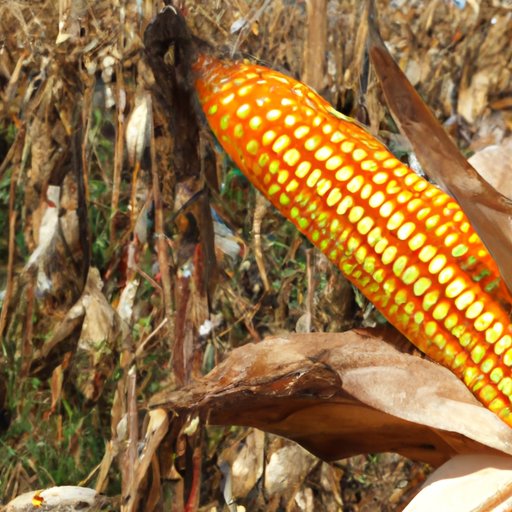I. Introduction
Maize, or corn, is an essential crop that is consumed by humans and animals worldwide. It is widely used in food production, biofuels, and various industrial applications. Determining which countries are the top producers of maize is an important task, as it helps us understand the global agricultural landscape and the economic impact of maize production on various countries. This article will explore the top maize-producing countries, key indicators that influence production levels, and the environmental and social impacts of maize production.
II. Exploring the Global Maize Production Landscape: Top Countries and Key Indicators
The top maize-producing countries are the United States, China, Brazil, and Argentina, making up 75% of global maize production.
The United States is the largest producer of maize in the world, with a production level of over 370 million metric tons in 2020. China, Brazil, and Argentina follow closely behind with production levels of 260 million metric tons, 102 million metric tons, and 51 million metric tons, respectively.
The key indicators that influence maize production levels include favorable climate, soil fertility, access to modern technology, adequate investments in agriculture, and government policies such as subsidies, trade tariffs, and land reform laws.
III. The Top Maize Producers in the World: Economic, Agricultural, and Political Factors Driving International Trade
The economic, agricultural, and political factors that drive international trade in maize include demand and supply dynamics, commodity prices, market regulations, international trade laws, and geopolitical tensions.
In recent years, maize has become a critical feedstock for bioenergy production, particularly in the United States and Brazil, where it is used as a primary raw material for ethanol production. The demand for maize in biofuel production has led to increased competition for maize among various industries.
The agricultural sector has also seen a rise in demand for maize, especially for livestock feed and food production. The growing population, particularly in developing countries, has led to an increased demand for maize for food production.
Political factors such as trade tariffs, subsidies, and trade wars affect the international trade of maize. For example, the US-China trade war has caused a significant decline in the export of US maize to China, creating opportunities for other maize-producing countries like Brazil and Argentina.
IV. From the Americas to Asia: A Comparative Study of High-Yielding Maize Cultivars and Leading Producers Globally
Different regions of the world have varying maize production levels due to factors such as climatic conditions, infrastructure, and technological advancements. In North America, high-yielding maize cultivars are widely used to increase productivity. In South America, the adoption of genetically modified maize has led to increased production levels.
Asia and Africa are emerging as new markets for maize production, with countries like India and South Africa slowly becoming significant maize producers. However, these countries face many challenges, such as poor infrastructure, limited access to modern technology, and unfavorable climatic conditions.
V. Digging into the Data: A Data-Driven Analysis of the World Maize Market Production and Export Trends
The data-driven analysis of the world maize market reveals that maize’s production has increased significantly over the past few decades, primarily due to the adoption of innovative technologies, such as high-yielding maize cultivars and genetically modified maize.
The major maize-producing countries export their maize to the world market, with the United States and Brazil dominating the export market. However, the COVID-19 pandemic has caused significant disruptions in international trade, leading to new trade regulations and policies.
VI. The Changing Dynamics of Global Maize Production: Forecasting the Future of Key Players and Emerging Markets
The future of maize production depends on various factors such as climate change, technological advancements, demand and supply dynamics, and geopolitical tensions. The United States, Brazil, and China are expected to maintain their positions as significant maize producers in the future.
Emerging markets like India, South Africa, and the Philippines are also expected to contribute significantly to global maize production, provided they can overcome the challenges of poor infrastructure and unfavorable climatic conditions.
VII. Beyond the Numbers: Understanding the Environmental and Social Impacts of Maize Production in Top Countries
The environmental and social impacts of maize production are significant and should not be overlooked. Maize production can lead to soil degradation, loss of biodiversity, and water pollution. It can also have adverse effects on the health of farmers and communities living near maize farms.
Therefore, it is essential to implement sustainable agricultural practices, such as crop rotation and agroforestry, to mitigate the environmental impacts of maize production. Additionally, social impacts such as equitable social distribution of resources in maize production and proper compensation for farmers should also be considered.
VIII. Challenging the Status Quo: Innovative Strategies for Enhancing Maize Productivity and Sustainability in Top Producers
Innovative strategies such as precision agriculture and the use of digital technologies can significantly enhance maize productivity and sustainability. For example, precision agriculture technologies can help farmers optimize the use of fertilizers and pesticides, reduce waste, and increase productivity. Digitization can also help small-scale farmers access markets and financial resources.
Sustainability in maize production can be enhanced by adopting agro-ecological farming practices such as intercropping and reducing soil tillage to increase soil health and reduce environmental degradation. Additionally, governments can support sustainability efforts by implementing policies that promote sustainable agricultural practices and provide incentives to farmers who adopt them.
IX. Conclusion
Maize is a crucial crop that plays a significant role in global agricultural and economic landscapes. The top maize-producing countries include the United States, China, Brazil, and Argentina, followed by other emerging markets. The factors that drive international trade in maize include supply and demand dynamics, market regulations, geopolitics, and technological advancements.
To enhance the productivity and sustainability of maize production, innovative strategies such as precision agriculture, digitization, and agroecology should be adopted. It is also essential to consider the environmental and social impacts of maize production and implement policies that promote sustainability and equitable distribution of resources.
